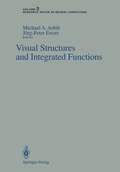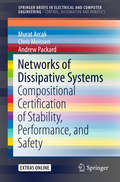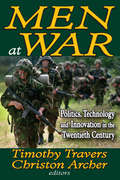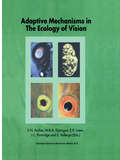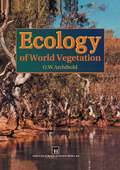- Table View
- List View
Current Topics in Microbiology and Immunology / Ergebnisse der Mikrobiologie und Immunitätsforschung: Volume 73 (Current Topics in Microbiology and Immunology #73)
by W. Arber W. Henle P. H. Hofschneider J. H. Humphrey N. K. Jerne P. Koldovský H. Koprowski O. Maaløe R. Rott H. G. Schweiger M. Sela L. Syru?ek P. K. VogtCurrent Topics in Microbiology and Immunology: Volume 79 (Current Topics in Microbiology and Immunology #79)
by W. Arber W. Henle P. H. Hofschneider J. H. Humphrey J. Klein P. Koldovský H. Koprowski O. Maaløe F. Melchers R. Rott H. G. Schweiger L. Syru?ek P. K. VogtCurrent Topics in Microbiology and Immunology: Volume 84 (Current Topics in Microbiology and Immunology #84)
by W. Arber W. Henle P. H. Hofschneider J. H. Humphrey J. Klein P. Koldovský H. Koprowski O. Maaløe F. Melchers R. Rott H. G. Schweiger L. Syru?ek P. K. VogtCurrent Topics in Microbiology and Immunology: Volume 82 (Current Topics in Microbiology and Immunology #82)
by W. Arber W. Henle P. H. Hofschneider J. H. Humphrey J. Klein P. Koldovský H. Koprowski O. Maaløe F. Melchers R. Rott H. G. Schweiger L. Syru?ek P. K. VogtCurrent Topics in Microbiology and Immunology (Current Topics in Microbiology and Immunology #78)
by W. Arber W. Henle P. H. Hofschneider J. H. Humphrey J. Klein P. Koldovský H. Koprowski O. Maaløe F. Melchers R. Rott H. G. Schweiger L. Syru?ek P. K. VogtCurrent Topics in Microbiology and Immunology (Current Topics in Microbiology and Immunology #77)
by W. Arber W. Henle P. H. Hofschneider J. H. Humprey J. Klein P. Koldovský H. Koprowski O. Maaløe F. Melchers R. Rott H. G. Schweiger L. Syru?ek P. K. VogtBiomedizin und Ethik: Praxis — Recht — Moral
by Werner Arber Hans-Peter SchreiberDer rasante Erkenntnisgewinn der letzten Jahrzehnte über Entstehung und Verlauf vieler Erkrankungen stellt unser Wissen auf eine neue Grundlage und eröffnet viel versprechende Entwicklungsmöglichkeiten präventiver und diagnostischer Verfahren und Therapien. Gleichzeitig dringt diese Forschung in Bereiche vor, die das Grundverständnis vom Menschsein tangieren, und uns zwingt, jene Begriffe neu zu überdenken, die für unser menschliches Selbstverständnis essentiell sind. An welchen normativen Kriterien sollen wir uns orientieren, um zwischen moralisch vertretbaren und moralisch verwerflichen Technikanwendungen sinnvoll unterscheiden zu können? Renommierte Beitragsautoren nehmen Stellung zu Themen, die anthropologische, ethische, rechtliche, kulturelle und soziale Fragen erzeugen: ethische und sozialpolitische Implikationen neuer molekulargenetischer Diagnostikverfahren; Perspektiven und Folgen von Klonierungstechniken; moralische und grundrechtliche Fragen der Embryonen- und Stammzellforschung; ethische Kritikpunkte hinsichtlich Patentschutz biotechnologischer Erfindungen. Ein wichtiger Beitrag zur aktuellen Bioethik-Debatte.
Visual Structures and Integrated Functions (Research Notes in Neural Computing #3)
by Michael A. Arbib Jörg-Peter EwertThis volume integrates theory and experiment to place the study of vision within the context of the action systems which use visual information. This theme is developed by stressing: (a) The importance of situating anyone part of the brain in the context of its interactions with other parts of the brain in subserving animal behavior. The title of this volume emphasizes that visual function is to be be viewed in the context of the integrated functions of the organism. (b) Both the intrinsic interest of frog and toad as animals in which to study the neural mechanisms of visuomotor coordination, and the importance of comparative studies with other organisms so that we may learn from an analysis of both similarities and differences. The present volume thus supplements our studies of frog and toad with papers on salamander, bird and reptile, turtle, rat, gerbil, rabbit, and monkey. (c) Perhaps most distinctively, the interaction between theory and experiment.
Technological Imagination in the Green and Digital Transition (The Urban Book Series)
by Eugenio Arbizzani Eliana Cangelli Carola Clemente Fabrizio Cumo Francesca Giofrè Anna Maria Giovenale Massimo Palme Spartaco ParisThis open access book addresses the pressing need for sustainability in urban development and the use of technology, with cities to serve as the main stage for strategies that seek to meet the targets and the cross-sector priorities indicated in the EU’s Next Generation program, all in pursuit of a solid recovery on the part of the European economy, along lines of ecological transition, digitalization, competitiveness, training, and inclusion to overcome social, territorial, and gender differences.The international study encounter is meant to promote visions shared by architectural technology and other disciplines, which, though they may appear to differ, are closely interconnected, with the aim of achieving an open, interdisciplinary integration capable of proposing concrete projects regarding topics held to be of strategic importance to the future of the built environment. These are identified to draw up evolving scenarios of architecture and cities suited to reflection, at various levels, on innovative models of process and product.
Networks of Dissipative Systems: Compositional Certification of Stability, Performance, and Safety (SpringerBriefs in Electrical and Computer Engineering)
by Murat Arcak Chris Meissen Andrew PackardThis book addresses a major problem for today’s large-scale networked systems: certification of the required stability and performance properties using analytical and computational models. On the basis of illustrative case studies, it demonstrates the applicability of theoretical methods to biological networks, vehicle fleets, and Internet congestion control. Rather than tackle the network as a whole —an approach that severely limits the ability of existing methods to cope with large numbers of physical components— the book develops a compositional approach that derives network-level guarantees from key structural properties of the components and their interactions. The foundational tool in this approach is the established dissipativity theory, which is reviewed in the first chapter and supplemented with modern computational techniques. The book blends this theory with the authors’ recent research efforts at a level that is accessible to graduate students and practising engineers familiar with only the most basic nonlinear systems concepts. Code associated with the numerical examples can be downloaded at extras.springer.com, allowing readers to reproduce the examples and become acquainted with the relevant software.
Nonlinear Signal Processing: A Statistical Approach
by Gonzalo R. ArceNonlinear Signal Processing: A Statistical Approach focuses on unifying the study of a broad and important class of nonlinear signal processing algorithms which emerge from statistical estimation principles, and where the underlying signals are non-Gaussian, rather than Gaussian, processes. Notably, by concentrating on just two non-Gaussian models, a large set of tools is developed that encompass a large portion of the nonlinear signal processing tools proposed in the literature over the past several decades. Key features include: * Numerous problems at the end of each chapter to aid development and understanding * Examples and case studies provided throughout the book in a wide range of applications bring the text to life and place the theory into context * A set of 60+ MATLAB software m-files allowing the reader to quickly design and apply any of the nonlinear signal processing algorithms described in the book to an application of interest is available on the accompanying FTP site.
Men at War: Politics, Technology, and Innovation in the Twentieth Century
by Christon ArcherThe growing number of books on military history and the lively interest in military history courses at colleges and universities show that the study of war is enjoying considerable popularity. The reasons for this are arguable, but of immediate interest is the kind of military history that is taught and written. Here the student of war comes across an interesting division of opinion as to how military history should be written. Military history, lying as it does on the frontier between history and military science, requires knowledge of both fields. This fact often presents a difficulty to the history teacher.Generally speaking, history is a discipline by virtue of its subject matter, not by virtue of a particular methodology such as is characteristic of the sciences and of some social sciences. The perspective of Men at War is a cross between a professional internalist approach and a civilian contextual view. This separation is not unique to military history, for the same dualism tends to occur in those areas of history, such as law and medicine, that can be written both by members of the profession concerned lawyers and doctors and by those outside the profession.The problem is that at one extreme the contextual view can take the emotional content out of war, while at the other extreme the internalist view can put too much in. Men at War seeks to locate a military history that combines the professional, internalist method and the civilian, contextual method by showing that these are two fundamental sources from which a war derives. Seen in this way, this volume breaks new ground in defining the sources of twentieth-century power.
Men at War: Politics, Technology, and Innovation in the Twentieth Century
by Christon ArcherThe growing number of books on military history and the lively interest in military history courses at colleges and universities show that the study of war is enjoying considerable popularity. The reasons for this are arguable, but of immediate interest is the kind of military history that is taught and written. Here the student of war comes across an interesting division of opinion as to how military history should be written. Military history, lying as it does on the frontier between history and military science, requires knowledge of both fields. This fact often presents a difficulty to the history teacher.Generally speaking, history is a discipline by virtue of its subject matter, not by virtue of a particular methodology such as is characteristic of the sciences and of some social sciences. The perspective of Men at War is a cross between a professional internalist approach and a civilian contextual view. This separation is not unique to military history, for the same dualism tends to occur in those areas of history, such as law and medicine, that can be written both by members of the profession concerned lawyers and doctors and by those outside the profession.The problem is that at one extreme the contextual view can take the emotional content out of war, while at the other extreme the internalist view can put too much in. Men at War seeks to locate a military history that combines the professional, internalist method and the civilian, contextual method by showing that these are two fundamental sources from which a war derives. Seen in this way, this volume breaks new ground in defining the sources of twentieth-century power.
The Long Thaw: How Humans Are Changing the Next 100,000 Years of Earth’s Climate
by David ArcherThe human impact on Earth's climate is often treated as a hundred-year issue lasting as far into the future as 2100, the year in which most climate projections cease. In The Long Thaw, David Archer, one of the world’s leading climatologists, reveals the hard truth that these changes in climate will be "locked in," essentially forever.If you think that global warming means slightly hotter weather and a modest rise in sea levels that will persist only so long as fossil fuels hold out (or until we decide to stop burning them), think again. In The Long Thaw, David Archer predicts that if we continue to emit carbon dioxide we may eventually cancel the next ice age and raise the oceans by 50 meters. A human-driven, planet-wide thaw has already begun, and will continue to impact Earth’s climate and sea level for hundreds of thousands of years. The great ice sheets in Antarctica and Greenland may take more than a century to melt, and the overall change in sea level will be one hundred times what is forecast for 2100. By comparing the global warming projection for the next century to natural climate changes of the distant past, and then looking into the future far beyond the usual scientific and political horizon of the year 2100, Archer reveals the hard truths of the long-term climate forecast. Archer shows how just a few centuries of fossil-fuel use will cause not only a climate storm that will last a few hundred years, but dramatic climate changes that will last thousands. Carbon dioxide emitted today will be a problem for millennia. For the first time, humans have become major players in shaping the long-term climate. In fact, a planetwide thaw driven by humans has already begun. But despite the seriousness of the situation, Archer argues that it is still not too late to avert dangerous climate change--if humans can find a way to cooperate as never before. Revealing why carbon dioxide may be an even worse gamble in the long run than in the short, this compelling and critically important book brings the best long-term climate science to a general audience for the first time. With a new preface that discusses recent advances in climate science, and the impact on global warming and climate change, The Long Thaw shows that it is still not too late to avert dangerous climate change—if we can find a way to cooperate as never before.
The Long Thaw: How Humans Are Changing the Next 100,000 Years of Earth’s Climate
by David ArcherThe human impact on Earth's climate is often treated as a hundred-year issue lasting as far into the future as 2100, the year in which most climate projections cease. In The Long Thaw, David Archer, one of the world’s leading climatologists, reveals the hard truth that these changes in climate will be "locked in," essentially forever.If you think that global warming means slightly hotter weather and a modest rise in sea levels that will persist only so long as fossil fuels hold out (or until we decide to stop burning them), think again. In The Long Thaw, David Archer predicts that if we continue to emit carbon dioxide we may eventually cancel the next ice age and raise the oceans by 50 meters. A human-driven, planet-wide thaw has already begun, and will continue to impact Earth’s climate and sea level for hundreds of thousands of years. The great ice sheets in Antarctica and Greenland may take more than a century to melt, and the overall change in sea level will be one hundred times what is forecast for 2100. By comparing the global warming projection for the next century to natural climate changes of the distant past, and then looking into the future far beyond the usual scientific and political horizon of the year 2100, Archer reveals the hard truths of the long-term climate forecast. Archer shows how just a few centuries of fossil-fuel use will cause not only a climate storm that will last a few hundred years, but dramatic climate changes that will last thousands. Carbon dioxide emitted today will be a problem for millennia. For the first time, humans have become major players in shaping the long-term climate. In fact, a planetwide thaw driven by humans has already begun. But despite the seriousness of the situation, Archer argues that it is still not too late to avert dangerous climate change--if humans can find a way to cooperate as never before. Revealing why carbon dioxide may be an even worse gamble in the long run than in the short, this compelling and critically important book brings the best long-term climate science to a general audience for the first time. With a new preface that discusses recent advances in climate science, and the impact on global warming and climate change, The Long Thaw shows that it is still not too late to avert dangerous climate change—if we can find a way to cooperate as never before.
Growth Stresses and Strains in Trees (Springer Series in Wood Science #3)
by Robert R. ArcherAlthough over 40 years have passed since Jacobs (1945) convincingly established the basic radial pattern of residual growth stress in growing trees, yet this phenomenon is still not widely appreciated in wood science and technology circles. This is in spite of the fact that the presence of these stresses of sizeable magnitudes has long been recognized as a primary cause of shakes and splits in logs as well as the warping of lumber sawn in the green condition. The presentation of the subject of growth stresses in trees presents some special problems due to the wide range of specialists who potentially might have an interest in the subject. For example, tree physiologists interested in questions such as the relation of mechanical stress to stem taper and the role of reaction wood and gravity forces in determining tree crown form encounter growth stress models. Silvi culturists interested in the relation ofthinning practices to wood quality find that wood properties are correlated with growth stress levels which are in turn significantly changed by cutting practices. Wood techno logists interested in the relation of residual growth stress gradients in green logs to the dimensional quality of sawn and seasoned lumber are forced to take a more quantitative approach to the effect of growth stresses than might have been the case in the past.
Inorganic and Organometallic Polymers (Special Topics in Inorganic Chemistry #4)
by Ronald D. ArcherA balanced and concise coverage of inorganic polymers Inorganic polymers contain elements other than carbon as part of their principal backbone structure and are known to exhibit a wide range of composition and structure. Emphasizing physical properties, chemical synthesis, and characterization of inorganic polymers, Inorganic and Organometallic Polymers presents valuable and informative coverage of the field. With numerous examples of real-world practical applications and end-of-chapter exercises, Inorganic and Organometallic Polymers is suitable for use as a text in special topics in organic and polymer chemistry courses. The book features useful sections on: Classification schemes for inorganic polymers Synthesis of inorganic polymers, including step-growth syntheses, chain polymerizations, ring-opening polymerizations, and reductive coupling reactions Practical inorganic polymer chemistry topics such as polymer elastomers, dental and medical polymers, lubricants, lithographic resists, pre-ceramics, and more Inorganic and Organometallic Polymers is a valuable one-volume introduction for professional and student inorganic chemists, polymer chemists, and materials scientists.
Adaptive Mechanisms in the Ecology of Vision
by S. Archer M. B. Djamgoz E. Loew J. C. Partridge S. VallergaJohn Lythgoe was one of the pioneers of the 'Ecology of Vision', a subject that he ably delineated in his classic and inspirational book published some 20 years ago [1]. At heart, the original book aimed generally to identify inter-relationships between vision, animal behaviour and the environment. John Lythgoe excelled at identifying the interesting 'questions' in the ecology of an animal that fitted the 'answers' presented by an analysis of the visual system. Over the last twenty years, however, since Lythgoe's landmark publication, much progress has been made and the field has broadened considerably. In particular, our understanding of the 'adaptive mechanisms' underlying the ecology of vision has reached considerable depths, extending to the molecular dimension, partly as a result of development and application of new techniques. This complements the advances made in parallel in clinically oriented vision research [2]. The current book endeavours to review the progress made in the ecology of vision field by bringing together many of the major researchers presently active in the expanded subject area. The contents deal with theoretical and physical considerations of light and photoreception, present examples of visual system structure and function, and delve into aspects of visual behaviour and communi cation. Throughout the book, we have tried to emphasise one of the major themes to emerge within the ecology of vision: the high degree of adaptability that visual mechanisms are capable of undergoing in response to diverse, and dynamic, environments and behaviours.
Potassium Channels in Cardiovascular Biology
by Stephen L. Archer Nancy J. RuschPotassium channels (K+) are membrane-spanning proteins which serve many important functions and are becoming a hot topic in physiology. K+ channels determine or modulate many functions of vascular smooth muscle, endothelial and inflammatory cells, and thus are central to regulation of arterial tone and control of cell proliferation. They are also promising targets for antihypertensive treatments with drugs which open and close specific types of K+ channels, making for an active field of research. With their ability to control vascular tone, voltage-gated K+ channels play a significant role in both pulmonary and systemic hypertension as well as in cardiac arrhythmias. This book will highlight the latest discoveries by leading researchers pertaining to the role of K+ channels in the heart and blood vessels in normal physiology and a variety of disease states.
One Plus One Equals One: Symbiosis and the evolution of complex life
by John ArchibaldWe are in the midst of a revolution. It is a scientific revolution built upon the tools of molecular biology, with which we probe and prod the living world in ways unimaginable a few decades ago. Need to track a bacterium at the root of a hospital outbreak? No problem: the offending germ's complete genetic profile can be obtained in 24 hours. We insert human DNA into E. coli bacteria to produce our insulin. It is natural to look at biotechnology in the 21st century with a mix of wonder and fear. But biotechnology is not as 'unnatural' as one might think. All living organisms use the same molecular processes to replicate their genetic material and the same basic code to 'read' their genes. The similarities can be seen in their DNA. Here, John Archibald shows how evolution has been 'plugging-and-playing' with the subcellular components of life from the very beginning and continues to do so today. For evidence, we need look no further than the inner workings of our own cells. Molecular biology has allowed us to gaze back more than three billion years, revealing the microbial mergers and acquisitions that underpin the development of complex life. One Plus One Equals One tells the story of how we have come to this realization and its implications.
Genomics: A Very Short Introduction (Very Short Introductions)
by John M. ArchibaldGenomics has transformed the biological sciences. From epidemiology and medicine to evolution and forensics, the ability to determine an organism's complete genetic makeup has changed the way science is done and the questions that can be asked of it. Its most celebrated achievement was the Human Genome Project, a technologically challenging endeavor that took thousands of scientists around the world 13 years and over 3 billion US dollars to complete. In this Very Short Introduction John Archibald explores the science of genomics and its rapidly expanding toolbox. Sequencing a human genome now takes only a few days and costs as little as $1,000. The genomes of simple bacteria and viruses can be sequenced in a matter of hours on a device that fits in the palm of your hand. The resulting sequences can be used to better understand our biology in health and disease and to 'personalize' medicine. Archibald shows how the field of genomics is on the cusp of another quantum leap; the implications for science and society are profound. ABOUT THE SERIES: The Very Short Introductions series from Oxford University Press contains hundreds of titles in almost every subject area. These pocket-sized books are the perfect way to get ahead in a new subject quickly. Our expert authors combine facts, analysis, perspective, new ideas, and enthusiasm to make interesting and challenging topics highly readable.
Genomics: A Very Short Introduction (Very Short Introductions)
by John M. ArchibaldGenomics has transformed the biological sciences. From epidemiology and medicine to evolution and forensics, the ability to determine an organism's complete genetic makeup has changed the way science is done and the questions that can be asked of it. Its most celebrated achievement was the Human Genome Project, a technologically challenging endeavor that took thousands of scientists around the world 13 years and over 3 billion US dollars to complete. In this Very Short Introduction John Archibald explores the science of genomics and its rapidly expanding toolbox. Sequencing a human genome now takes only a few days and costs as little as $1,000. The genomes of simple bacteria and viruses can be sequenced in a matter of hours on a device that fits in the palm of your hand. The resulting sequences can be used to better understand our biology in health and disease and to 'personalize' medicine. Archibald shows how the field of genomics is on the cusp of another quantum leap; the implications for science and society are profound. ABOUT THE SERIES: The Very Short Introductions series from Oxford University Press contains hundreds of titles in almost every subject area. These pocket-sized books are the perfect way to get ahead in a new subject quickly. Our expert authors combine facts, analysis, perspective, new ideas, and enthusiasm to make interesting and challenging topics highly readable.
Ecology of World Vegetation
by O.W. ArchiboldThe ecology of world vegetation is described in numer all of the drafting and photographic work. They have ous books and journals, but these are usually very spe spent many hours on this project and their care and skill cialized in their scope and treatment. This book provides is reflected in the consistently high quality of the illus a synthesis of this literature. A brief introductory chap trations throughout the book. Many friends and col ter outlines general ecological concepts and subsequent leagues have provided photographs. It has not been chapters examine the form and function of the major possible to include all of them, but the 'global' perspect biomes of the world. A similar organization has been ive of the book has been greatly enhanced in this way. used for each biome type. These chapters begin with a I wish to thank them all for the time and trouble they description of environmental conditions and a brief have taken to supply this material. I must also thank account of floristic diversity in a regional context. The Mary Dykes and the staff of the interlibrary loans de remaining pages describe characteristic adaptations and partment of the Library, University of Saskatchewan, ecosystem processes. for their unfailing ability to get even the most obscure Although there is a rapidly growing literature on eco references.
Nonlinear Systems, Vol. 2: Nonlinear Phenomena in Biology, Optics and Condensed Matter (Understanding Complex Systems)
by Juan F. Archilla Faustino Palmero M. Carmen Lemos Bernardo Sánchez-Rey Jesús Casado-PascualThis book presents an overview of the most recent advances in nonlinear science. It provides a unified view of nonlinear properties in many different systems and highlights many new developments.While volume 1 concentrates on mathematical theory and computational techniques and challenges, which are essential for the study of nonlinear science, this second volume deals with nonlinear excitations in several fields. These excitations can be localized and transport energy and matter in the form of breathers, solitons, kinks or quodons with very different characteristics, which are discussed in the book. They can also transport electric charge, in which case they are known as polarobreathers or solectrons. Nonlinear excitations can influence function and structure in biology, as for example, protein folding. In crystals and other condensed matter, they can modify transport properties, reaction kinetics and interact with defects. There are also engineering applications in electric lattices, Josephson junction arrays, waveguide arrays, photonic crystals and optical fibers. Nonlinear excitations are inherent to Bose-Einstein Condensates, constituting an excellent benchmark for testing their properties and providing a pathway for future discoveries in fundamental physics.
Ecosystem Services and Green Infrastructure: Perspectives from Spatial Planning in Italy (Cities and Nature)
by Andrea Arcidiacono Silvia RonchiThe book analyses the relationship between ecosystem services, green and blue infrastructures (GBI) and spatial planning in Italy. It provides insights on the opportunities and challenges in the adoption of an ecosystem services (ES)-based approach for Spatial Planning exploring methods and techniques for the design of GBI strategies. Nowadays, there is an advance in ES knowledge and a recognition of the benefits of GBI for the quality of human life and biodiversity conservation. The main challenge remains how this knowledge could be integrated into the planning process and how it could guide the decision-making process towards sustainable development for contemporary cities. The book collects innovative Italian experiences providing important considerations for operationalizing the ES concept and highlighting different disciplinary attitudes and methodological approaches with the common goal to enhance human well-being.







